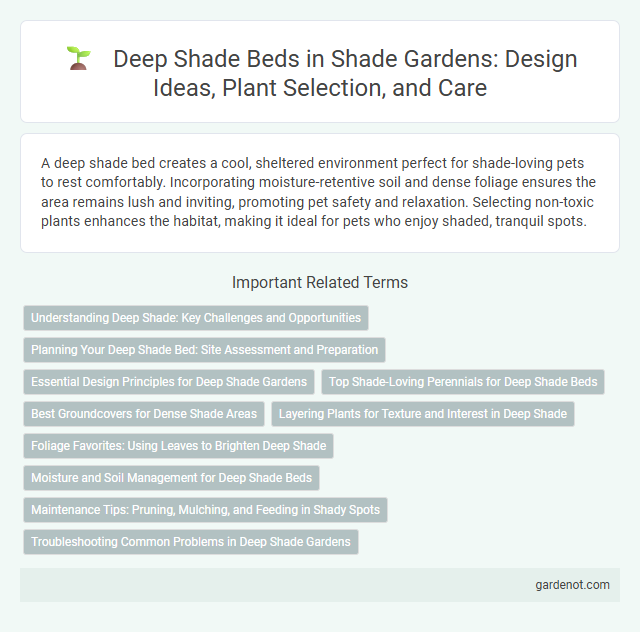A deep shade bed creates a cool, sheltered environment perfect for shade-loving pets to rest comfortably. Incorporating moisture-retentive soil and dense foliage ensures the area remains lush and inviting, promoting pet safety and relaxation. Selecting non-toxic plants enhances the habitat, making it ideal for pets who enjoy shaded, tranquil spots.
Understanding Deep Shade: Key Challenges and Opportunities
Deep shade beds present unique challenges such as limited sunlight, which restricts photosynthesis and plant growth, making plant selection critical for success. Understanding the microclimate of deep shade areas helps gardeners optimize soil moisture, aeration, and nutrient availability, enhancing plant health and resilience. Opportunities arise from cultivating shade-tolerant species like hostas, ferns, and astilbes that thrive in low-light conditions, creating lush, visually appealing garden spaces.
Planning Your Deep Shade Bed: Site Assessment and Preparation
Assess soil moisture, drainage, and light availability to ensure optimal conditions for your deep shade bed. Clear debris and amend the soil with organic matter like compost to improve fertility and structure. Map out the bed considering plant spacing and growth habits for a thriving shade garden.
Essential Design Principles for Deep Shade Gardens
Deep shade beds require careful selection of shade-tolerant plants such as hostas, ferns, and heucheras to ensure lush foliage and color contrast. Soil preparation emphasizing rich organic matter and moisture retention is critical for healthy root development in low-light conditions. Incorporating layered planting with varying heights enhances visual interest and maximizes the limited sunlight available in deep shade gardens.
Top Shade-Loving Perennials for Deep Shade Beds
Top shade-loving perennials for deep shade beds include hostas, ferns, and astilbes, which thrive in low-light conditions and offer lush foliage and vibrant blooms. Heucheras provide colorful leaves that brighten shaded areas, while pulmonaria contributes attractive spotted foliage and spring flowers. These perennials enhance shade gardens by creating texture, color, and year-round interest in deep shade environments.
Best Groundcovers for Dense Shade Areas
Best groundcovers for dense shade areas thrive in low light by offering durable foliage and soil protection. Varieties such as Pachysandra terminalis, Vinca minor, and Heuchera provide lush greenery and suppress weeds effectively in deep shade beds. These plants improve soil health and moisture retention while enhancing the aesthetic value of shaded garden spaces.
Layering Plants for Texture and Interest in Deep Shade
Creating a deep shade bed requires strategic layering of plants to enhance texture and visual interest in low-light conditions. Combining ground covers, mid-height shrubs, and taller shade-tolerant perennials like Hostas, ferns, and Astilbes creates dynamic depth and varied foliage shapes. Selecting species with contrasting leaf colors and textures ensures a vibrant and engaging shade garden throughout the growing season.
Foliage Favorites: Using Leaves to Brighten Deep Shade
Deep shade beds thrive with foliage favorites like hostas, ferns, and Heuchera, which offer vibrant textures and colors to enliven dark garden corners. Broad-leaved plants with variegated or silver-toned foliage reflect limited light, creating visual interest and contrast in shady areas. Incorporating diverse leaf shapes and hues maximizes depth and brightness, transforming deep shade beds into lush, dynamic landscapes.
Moisture and Soil Management for Deep Shade Beds
Deep shade beds require careful moisture and soil management to ensure healthy plant growth in low-light conditions. Maintaining consistently moist, well-draining soil rich in organic matter such as compost or leaf mold enhances nutrient availability and prevents waterlogging. Regular mulching conserves soil moisture, regulates temperature, and improves soil structure, promoting a thriving deep shade garden ecosystem.
Maintenance Tips: Pruning, Mulching, and Feeding in Shady Spots
To maintain a deep shade bed, regularly prune plants to improve air circulation and prevent overcrowding, ensuring healthy growth in low-light conditions. Apply a thick layer of organic mulch to retain moisture, regulate soil temperature, and suppress weeds common in shaded areas. Use shade-adapted slow-release fertilizers rich in nitrogen and potassium to support nutrient uptake without overwhelming delicate shade plants.
Troubleshooting Common Problems in Deep Shade Gardens
Deep shade beds often face issues like poor air circulation leading to fungal diseases and slow plant growth due to insufficient sunlight. Address common problems by improving soil drainage, selecting shade-tolerant plants such as hostas and ferns, and regularly removing debris that harbors pests or disease. Monitoring moisture levels and applying organic mulch can also help maintain plant health in deep shade gardens.
Deep shade bed Infographic

 gardenot.com
gardenot.com